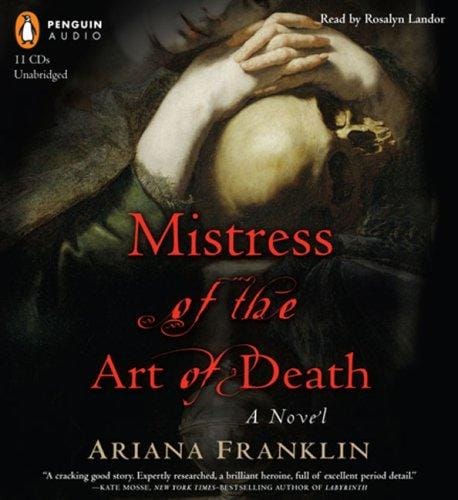Mistress of the Art of Death – A Dark Medieval Mystery Worth Rediscovery
Explore plot, themes, and historical detail in Ariana Franklin's Mistress of the Art of Death—a gripping medieval mystery starring trailblazing doctor Adelia Aguilar.

Introduction
When Ariana Franklin released "Mistress of the Art of Death" in 2007, readers were immediately pulled into a world where twelfth-century politics meet modern forensic curiosity. Blending the tense atmosphere of a crime thriller with the scrupulous detail of well-researched historical fiction, the novel follows a female doctor from Salerno sent to medieval England to solve a string of child murders. Sixteen years on, Franklin’s page-turner continues to win new fans because it does more than entertain; it re-imagines who exercised power, knowledge, and empathy in an era often written by men and for men.
Plot Overview Without Spoilers
The story opens in 1171, when King Henry II invites a team of investigators from the famed medical school of Salerno to Cambridge. Four local children have been found brutally slain, and English Christians are blaming the city’s Jewish community. Into this fevered environment steps Adelia Aguilar, a trained physician and early anatomist—"mistress of the art of death"—who must disguise her expertise lest she be accused of witchcraft. Adelia, accompanied by a Saracen bodyguard and a Jewish investigator, employs scientific observation, early forensics, and acute psychological insight to identify the killer while navigating the political minefield of church, crown, and town.
Rich Historical Backdrop
Franklin—pen name of journalist and historian Diana Norman—recreates Angevin England with sensory detail. Muddy streets, candlelit chambers, and bustling marketplaces serve as more than set dressing; they shape every character’s opportunities and fears. King Henry II’s fraught relationship with the Church after Thomas Becket’s murder hovers ominously in the background, adding urgency to Adelia’s investigation. The author’s knowledge of medieval medicine, crusader politics, and Jewish-Christian tensions grounds the narrative in authenticity while avoiding the info-dump trap that plagues lesser historical novels.
Meet Adelia Aguilar
Adelia stands out in historical fiction as a woman wielding rationalism in a superstitious age. Educated in Salerno, one of the few medieval institutions to admit women, she is fluent in Arabic, Latin, and the language of cadavers. Yet her brilliance is also her vulnerability. English society forces her to masquerade as an interpreter for her bodyguard Mansur, who publicly poses as the doctor. This reversal not only ratchets up dramatic tension but also surfaces timely questions about gendered labor and stolen credit—issues still debated in modern workplaces.
The Mystery Element
Murder mysteries hinge on pacing and misdirection, and Franklin excels at both. Red herrings lurk in gossip-filled taverns and church cloisters alike. Dialogues crackle with wit, yet every quip advances the investigation. Forensic tidbits—identifying knife wounds, assessing decomposition, reading footprints—are sprinkled like breadcrumbs. Readers accustomed to contemporary crime novels will find familiar thrills, all the more tantalizing for emerging from an era predating fingerprints and DNA.
Science Versus Superstition
One of the novel’s central themes is the clash between empirical evidence and religious dogma. Adelia’s autopsies evoke horror from observers who deem her practice sacrilege, mirroring the historical Church prohibition against dissection. Franklin uses these scenes to showcase the slow, perilous birth of scientific method. Each anatomical observation becomes an act of rebellion, underscoring how knowledge often advances through small, courageous transgressions.
Faith, Tolerance, and Minority Voices
Far from painting religion with a broad, villainous brush, Franklin explores its nuances. Jewish moneylenders, Christian monks, and Muslim scholars coexist uneasily, bound by trade and royal edict more than genuine acceptance. By humanizing each group, the novel critiques scapegoating and xenophobia—issues that remain painfully current. The plot’s ticking clock amplifies the stakes: if Adelia fails, Cambridge’s Jewish quarter faces annihilation, foreshadowing real pogroms that later swept Europe.
Comparable Reads
Fans of Ellis Peters’s Brother Cadfael series will appreciate Franklin’s meticulous research and compassionate eye, though "Mistress of the Art of Death" features a darker tone and more graphic forensic detail. Readers who enjoy the gender-bending scholarship of Umberto Eco’s "The Name of the Rose" or the atmospheric dread of C.J. Sansom’s Matthew Shardlake mysteries will likewise feel at home. Yet Adelia’s distinct voice and the fusion of medical thriller with medieval whodunit give the book a niche all its own.
Why the Novel Still Resonates
Beyond its clever plot, the book invites reflection on who gets to practice science, who writes history, and how societies decide which lives matter. In an age when misinformation spreads at lightning speed, Adelia’s insistence on evidence offers a potent lesson. Meanwhile, her necessity to conceal her competence echoes ongoing struggles for recognition faced by women and minorities across professional fields. Franklin’s narrative reminds us that progress is rarely linear and often fragile.
Sequels and Legacy
"Mistress of the Art of Death" launched a series that continued with "The Serpent’s Tale," "Grave Goods," and "A Murderous Procession." Each installment further develops Adelia’s relationship with Henry II’s court and deepens her moral quandaries. Though Franklin passed away in 2011, leaving some narrative threads unresolved, her influence endures. The resurgence of interest in historically set crime fiction owes much to her seamless blending of scholarship and suspense.
Conclusion
Whether you arrive for the mystery, the meticulously crafted setting, or the unforgettable heroine, "Mistress of the Art of Death" delivers an immersive reading experience. Pick it up to discover how a medieval autopsy can feel shockingly modern—and how storytelling can resurrect forgotten voices from a distant past.



